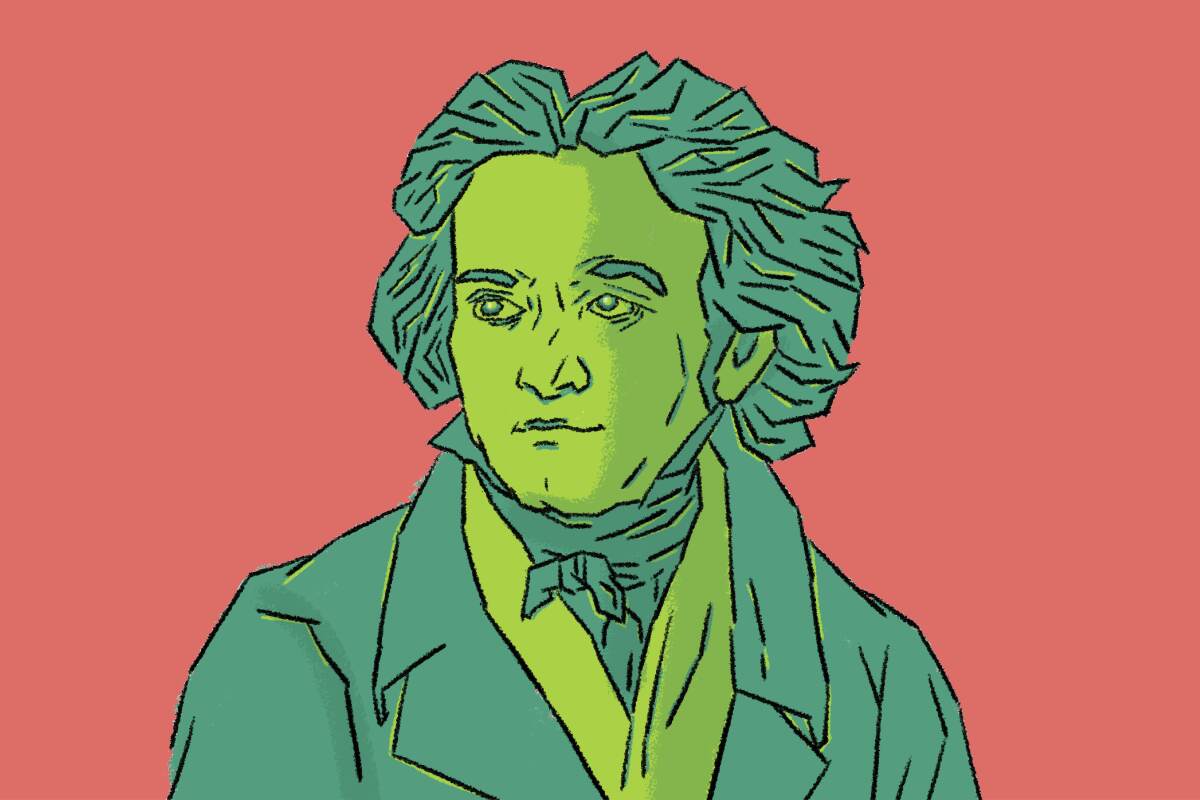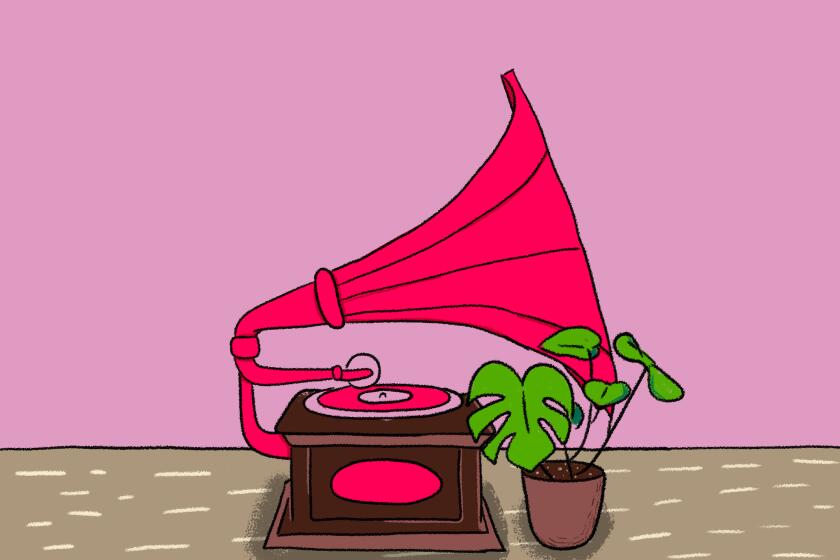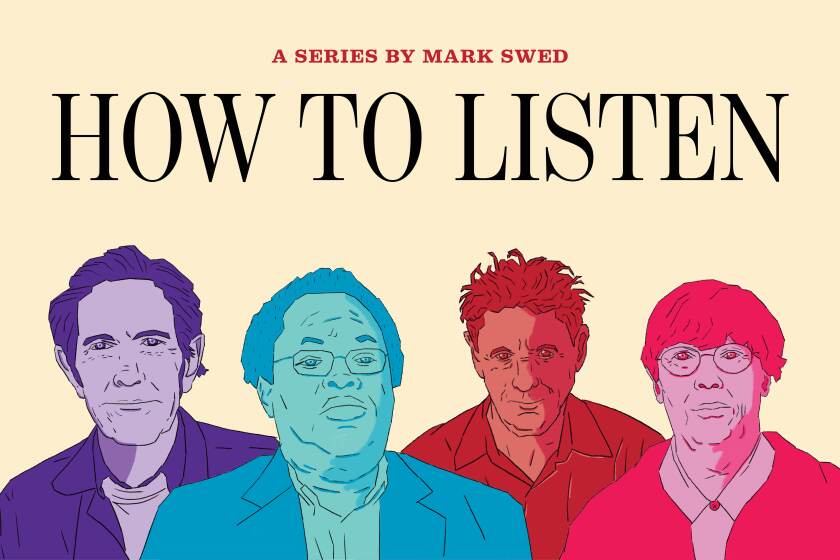Beethoven for pandemic times: How Opus 132 is journey through illness and healing

Beethoven’s Opus 132 conveys how disease can change our perception of the world.
How to Listen: Beethoven String Quartet No. 15 in A Minor, Op. 132
When we finally see the return of concerts, shared experiences by full audiences, everyone together, the moment will be less for fireworks than for thanksgiving. Let us begin, then, with Beethoven as the spiritual guide to healing and its meaning.
In 1825, two years before he died, the ailing composer suffered from a dreadful bowel inflammation. Throughout spring and summer, he endured the ghastly Brunonian system of medicine that wound up killing more people than the Napoleonic wars. Once recovered, he wrote a string quartet in which he represented the psychology of pain and illness in all its transcendent transparency. His Opus 132, also known as String Quartet No. 15 in A Minor, neither has nor intends intrinsic healing power. Beethoven, instead, conveys the changes of perception wrought by disease.
The heart of the quartet might be translated from the German title Beethoven gave the central movement, “Song of Thanksgiving, in the Lydian Mode, Offered to the Divinity by a Convalescent.” In a classic 1978 study of Beethoven’s string quartets, musicologist Joseph Kerman wrote of the movement’s “rarified atmosphere, whispered by a convalescent who has just, and barely, passed a supreme crisis. He still seems to be under oxygen.” A visionary composer’s spiritually uncompromising yet physically compromised vision is “of new strength, not attained and perhaps never.”
Ecstasy and excess, rhythm and repetition, gender and ethnicity. Lyricism, protest, healing. Critic Mark Swed’s series on the ideas embedded in every note.
Could Opus 132 be a COVID-19 quartet written nearly two centuries before our pandemic? The answer is yes and no. It all depends on how you listen and what you listen for.
The first striking impression Opus 132 makes may be of inexplicable extremes. Churchly quiet emanates from all four slow-moving string players, suddenly broken by an agitated first violin. A short, yearning (hopeful, consoling, despairing — take your pick) motif follows, interrupted by more eruptions followed by more yearning. A lovely melody emerges, with a vamping accompaniment that, depending on how it’s played and the tempo, is either a glimpse at normality or a distortion of it.
Either way, the patient is not improving. Contrasts continue; themes develop and dissipate as they might in a state of delirium. The second movement finds the patient perhaps stepping out too soon into the world, but not yet of it. A dreamlike contrasting middle section suggests the illusionary sound of bagpipes heard in the distant countryside.
The extraordinary middle movement of thanksgiving captures the state sufferers most crave: those unmistakable early stirrings of recovery. For Beethoven, lack of strength was a mystical void, a suspension between reality and unreality. The opening hymn tune of divine thanks is thus introduced as placid, bland, devoid of drama, drained of emotion. Being in the Lydian mode, it has no conventional harmonic tension.
The mode, which can be approximated by playing only the white notes on the piano, happens to be a scale developed by the ancient Greeks as a remedy for fatigue of body and soul. With its gloriously pure, equal intervals, it later found pious favor in the Medieval church music, becoming a way station in the development of the Western harmony.
The Lydian here is an anachronism evoking a lost, numinous realm. The hymn is twice interrupted by grandiose, bounding sections of uplift in the A-minor. These stirrings come out of nowhere and don’t last. They may be the new vigor or a dying body’s final exuberance.
Meanwhile the placid hymn undergoes a gradual process of erasure. On its first appearance, each phrase of the hymn is introduced with musical decorations that serve as the aural equivalent of illustrated manuscripts. The decorations become livelier after each uplift, eventually overwhelming the hymn in unexpectedly ecstatic climax.
Kerman sees this as Beethoven out-of-body, back-in-body, further out-of-body, resiliently back-in-body, ambiguously way out-of-body. The quartet ends with a march, a recitative and thrillingly passionate aria-like finale. Play it one way and life is affirmed.
Play it with an extra dose of angst, and it becomes Beethoven marching out of the hospital and then freaking out when he gets the bill. Or at least that was my sophomoric way of mimicking Kerman after hearing him espouse his theories on the meaning of Opus 132 in a seminar on the Beethoven quartets he taught at UC Berkeley while writing his landmark study. I attended that seminar with a chip on my shoulder over his narrative that turned a profound musical creation into commonplace story about crisis management, no matter how astutely Kerman backed this up with harmonic and formal analysis.
It was an era of music hailed as the epitome of abstraction — and psychedelics. Out-of-body meant just that, and all the experimental new music said so, be it music of incomprehensible complexity, mysterious electronic sounds or the burgeoning new Minimalism of Terry Riley, Steve Reich and Philip Glass. The beauty of Beethoven’s late string quartets, for young musical revolutionaries, was in their technical razzle-dazzle. All else was cheap thrills.
Kerman’s Beethoven string quartet class turned out to be a last-minute substitution for a seminar on Webern. A composer of jewel-like miniatures of dazzlingly pure abstraction, Webern had been a key inspiration for the post-World War II avant-garde in Europe and America. That is what we had signed up for, not Beethoven romanticized.
If we revered Beethoven, it was as an unapologetic revolutionary, a beacon for musical reinvention in his late string quartets, his greatest music and among the most consequential music ever written. The only way to hear Opus 132 was as a cornucopia of possibilities. Let the Lydian mode proclaim not the past but the future. Everything must be transformed was our rallying cry.
What does reopening look like? With Mirga Grazinyte-Tyla and Zubin Mehta conducting, orchestras return with tiny audiences and distanced musicians.
Yet rereading Kerman as tens of thousands of Americans die from COVID-19 and millions more deal with disease in all its implications, Beethoven’s guide to healing has unmistakable resonance and relevance. Indeed, with amazing prescience, the string quartet Brooklyn Rider commissioned five composers to write short movements in response to Opus 132. Called “Healing Modes,” the project has been recorded and, prior to the spring coronavirus cancellations, had been scheduled to be performed in April in Santa Barbara.
Composers from a variety of backgrounds and cultures respond not to Beethoven’s music but to ways of applying Beethoven’s healing to their own causes. Carolyn Shaw solemnly shadows Syrian refugees. Du Yun hauntingly evokes the Alice in Wonderland syndrome under which one perceives body parts out of proportion.
In fact, Beethovenian healing goes far further. Less than a year after an American soldier in 1945 occupied Vienna accidentally shot and killed Webern as he smoked a cigar on his apartment balcony, the composer’s mentor, Arnold Schoenberg, had a near-death experience. He collapsed and lost consciousness from a heart seizure in his house in Brentwood. A doctor gave Schoenberg a life-saving injection of Dilaudid directly in the chest.
Recovering, Schoenberg wrote his String Trio in response to his essential quest for “peace and repose” after intense “pain and suffering.” Like Opus 132, Schoenberg’s trio is in five parts, and it is an example of excessive, often violent, contrast. Like Beethoven’s, it is a work of extraordinary technical complexity.
Coronavirus may have silenced our symphony halls, taking away the essential communal experience of the concert as we know it, but The Times invites you to join us on a different kind of shared journey: a new series on listening.
Schoenberg, however, described it as a humorous road map to his own experiences of disease and recovery. The delirium is for real, not simply for music’s sake. Fractured snippets of waltz are 20th century versions of otherworldly Beethoven. Sharp, loud pizzicato chords are injections from Schoenberg’s hulking nurse, Gene. When disorientated music at the beginning returns at the end less fraught, it is in no way a return to normality but a new way of hearing. Health regained is the end of what Susan Sontag calls disease’s “psychic voyage.”
Modern disease metaphors are all cheap shots, Sontag also warns us in “Illness as Metaphor.” In Beethoven and Schoenberg, there is no sentimentality. Their psychic voyage is apprehension of the most intense experience a person can have. Healing is when every sensation has new meaning, and every note matters.
Starting points
There are a wealth of recordings of Beethoven, but there is a particular value in two great American string quartets who not only recorded Opus 132 but also worked with Schoenberg around the time of his illness.
The Juilliard String Quartet has a 1974 version of Opus 132 (the second of the ensemble’s three recordings, now available in hi-res on some sites such as qobuz.com) has a febrile force, as does its recording of Schoenberg’s String Trio.
The LaSalle Quartet recordings of both pieces exude humanity. Its Beethoven is available as a hi-res download through Presto Classical as well as glorious vinyl.
The Hollywood String Quartet, made up of studio musicians, was an ensemble favored by Schoenberg. Its version of Beethoven’s Opus 132 is heart-wrenchingly deep drama.
Check back for new installments of “How to Listen” every Wednesday at latimes.com/arts, and support this work and The Times’ other coverage of arts with a digital subscription.
More to Read
The biggest entertainment stories
Get our big stories about Hollywood, film, television, music, arts, culture and more right in your inbox as soon as they publish.
You may occasionally receive promotional content from the Los Angeles Times.













